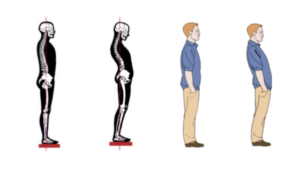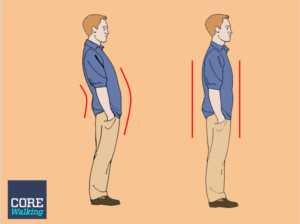
What’s so great about standing up straight?
Absolutely nothing. And I mean that.
At least the “straight” that has been hammered into you your whole life.
Standing up straight, as you know it, is an illusion and an ideal created by parents and teachers with some strange aesthetics.
-Stand up straight!
-Take Your Shoulders back!
-Lift your chest!
These are all horrible instructions. And I do mean horrible. Truly horrible.
They might be well-intentioned but they’re not helpful.
Let’s look at these standard directions one by one.
Standing Up Straight
I see the body in terms of balance and I rarely see the balance between the front and back of our bodies.
We are all splayed open to one degree or another, tending to be tight in the back of the body.
Tight hamstrings, tight lower backs, tight suboccipital muscles (just below the head). This is fairly common.
Tightness in these muscle groups hampers the quest for a balanced body.
And telling someone to stand up straight over and over again actually pulls us backward. And all that does is reinforce all of the tightness already there.
Have someone take a picture of you “standing up straight”. I promise you the straighter you try to make yourself, the more you will lean backward.
Take Your Shoulders Back
Did you hear this every day of your childhood?
I did.
And I might even have tried to do it. Why?
I can’t tell you for sure as there is zero, with a capital Z, benefit to taking your shoulders back.
I know you hear it in most yoga classes, and I apologize for that because it is a terrible instruction.
This simplest way I can express how bad this instruction is by stating that the arm is meant to hang. The arm should hang freely from the shoulder with a tremendous range of motion.
Don’t Believe Everything You Hear
 Taking your shoulders back locks the arms into their sockets, decreasing rather than increasing their range of motion.
Taking your shoulders back locks the arms into their sockets, decreasing rather than increasing their range of motion.
Arms that hang are essential to having good posture, which is different than your parent’s idea of standing up straight.
It’s kind of wild but the shoulder girdle hangs from the head. It only connects to the ribcage in one place.
And the arm hangs from the shoulder girdle which can only happen when our bodies have good front-to-back balance.
As soon as you “take your shoulders back”, they no longer hang and their range of motion decreases.
Try it and see for yourself. Stand up in your image of straight and then basically relax, even sigh. And then feel your arms and how they hang.
Lift Your Chest
This is another one that I simply don’t get.
Technically, if someone tells you to lift your chest and you do it equally from the front and the back of the body, it is a fine instruction.
But most often the instruction is coupled with the first instruction, take your shoulders back.
Taken together this usually results in the front of the ribcage elevating and the back of the body shortening.
All of the action happens in the front and the lift elevates the front of the rib cage and not the back.
This interrupts the free flow of your breath, preventing the breath from truly filling the trunk.
As always, the proof is in the pudding.
Give it a try. Stand up and find the posture that allows you the fullest breath. I promise you that when you breathe well you won’t be taking your shoulders back or lifting your chest.
Standing up straight is relative.
The body is a gloriously dynamic form that never stops moving but there is a place of balance where all things find their place.
Find it for yourself and don’t listen to those antiquated instructions from your past.
